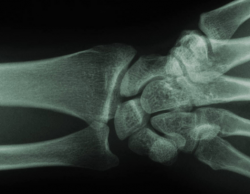
September 29, 2012 (San Diego) -- Arthritis is the leading cause of disability in the United States with more than 46 million Americans having doctor‐diagnosed arthritis (National Center for Chronic Disease Prevention and Health Promotion, 2009). As joint pain is an extremely prevalent condition that many Americans face daily, new advances in technology for the delivery of image-guided injections are available.
Dr. Benjamin DuBois, a fellowship-trained orthopaedic surgeon at Grossmont Orthopaedic Group in La Mesa, answers our questions about the causes of joint pain and the treatment options.
Q. What are some of the common causes of joint pain?
A. One of the most common causes of joint pain is arthritis, a chronic inflammatory condition that results from trauma or degenerative changes in the joints like the knee, hip and shoulder. The most common types of arthritis include osteoarthritis and rheumatoid arthritis.
In addition to arthritis, joint pain may be caused by significant strain or force due to intense physical activity or injury, as well as autoimmune disease, infectious disease, bursitis and tendonitis, and normal wear that occurs as we age. Regardless of the cause, joint pain is a debilitating condition that can severely affect everyday activities and quality of life.
Q. How does joint pain occur?
A. Joint pain frequently occurs due to the breakdown of cartilage, a smooth tissue in the joint that acts as a cushion between two bones. As cartilage breaks down, the two bones rub together resulting in inflammation, pain and reduced range of motion. If left untreated, arthritis can lead to long-term joint damage, pain and disability.
Q. How is joint pain traditionally treated?
A. Oral pain-killers have long been prescribed as an early intervention for joint pain. While they may work in the short term, pain killers can become addictive and repeated use of some has been shown to cause severe side effects including stomach related-deaths. Several oral pain killers, known as COX-2 inhibitors, were even recalled by the FDA due to these side effects. Depending on the nature of the disability, surgery may also be recommended. However, surgery can be costly and invasive procedures—like total joint replacements—often require months of rehabilitation.
Q. What are some alternative treatments?
A. A popular alternative to oral medications and one that can delay, or in some cases eliminate, the need for surgery is a joint injection procedure. Joint injections combine a corticosteroid and anesthetic agents that can lead to a rapid decrease in pain and inflammation without the side effects of oral medications. In many instances, these minimally invasive and cost-effective treatments can delay and even eliminate the need for surgical intervention.
However, like most procedures, the success of the procedure depends on the expertise of the clinician and the accuracy with which the medications are injected into the affected joint space. Accurate drug delivery may also help reduce the need for repeat injections, which in turn reduces costs and improves patient care. A patient may receive orthopedic injections every few months, as their prescribed method of pain management.
Q. How is ultrasound being used help ensure injection accuracy?
A. Ultrasound has expanded into a variety of clinical applications thanks to advances in the field. While it has long been used in orthopaedics to diagnose conditions, it has recently been shown to be an effective tool to pinpoint the exact location of where the injected medicine will be most effective. Recent studies have found that accuracy rates are significantly higher when imaging is used in conjunction with injection (The American Journal of Sports Medicine, 2011). At Grossmont Orthopaedic Group, we are using a new device called the Navigator® Delivery System (DS), which combines ultrasound technology with a computer-controlled drug delivery system.
Q. How does The Navigator DS work?
A. The Navigator DS prepares the prescribed medication, while the ultrasound screen provides me and the patient with a real-time view of the joint, needle position, drug delivery and prescription volume.
Q: What are the benefits of The Navigator DS?
A. The Navigator DS’ ultrasound screen allows physicians to pin-point needle placement to help ensure that the drug is delivered to the painful joint. Accurate drug delivery may help to reduce the need for repeat injections, which helps to reduce costs and improve patient care. The system’s precise dose preparation also helps to ensure that doctors use no more or fewer drugs than needed for the patient. Additionally, the Navigator DS also improves efficiency, safety and sterility of the procedure.
For more information on treatment for musculoskeletal injuries, visit http://www.sandiegoshoulderdoc.com/ or call Grossmont Orthopaedics at (619) 462-3131.
Q: What are the cautionary aspects of joint injections in general?
A: While there are many advantages to receiving joint injections, there are some additional points to keep in mind. No more than three to four steroid injections per year in the same joint are recommended. If injected more frequently, there is a risk of injury to the affected joint. It is important to keep in mind that injections are used to decrease pain and inflammation while consequently improving function of the joint. Injections do not, however, cure the underlying problem.
Knowing the Facts about Joint Pain
· Approximately 30 percent of American adults experience some type of joint pain.
· Many different conditions can lead to painful joints, including: osteoarthritis, rheumatoid arthritis, bursitis, gout, strains, sprains
and athletic injuries.
· Arthritis is the leading cause of disability in the United States, affecting more than 46 million Americans.
· By 2030, 67 million Americans are expected to have arthritis.
Cited: 1) http://www.cdc.gov/NCCDPHP/publications/aag/pdf/arthritis.pdf ; 2) The American Journal of Sports Medicine; 2011;39(3):656-662.








Recent comments